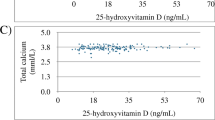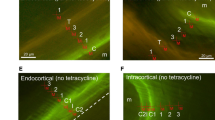Summary
Lymphosarcoma of domestic dogs is often accompanied by hypercalcemia. We have carried out studies to determine the usefulness of this common canine neoplasm as a model for paraneoplastic hypercalcemia. The study population consisted of 27 healthy control dogs, 13 with hypercalcemic lymphosarcoma, and 28 normocalcemic dogs with lymphosarcoma. Studies included measurement of circulating calcium, phosphorus, creatinine, immunoreactive parathyroid hormone (iPTH) and prostaglandin E2 (iPGE2) concentrations, and determination of in vitro bone-resorbing activity in supernatant culture media from normal and neoplastic lymphoid tissue. Hypercalcemia was severe in the affected group (mean ± SE, 14.9±0.5 mg/dl, normals 10.1±0.1 mg/dl) and associated with decreased renal function (serum creatinine 2.0±0.4 mg/dl, normal 0.8±0.1 mg/dl,P<0.001). Radiographs and autopsies showed no bone destruction. Despite renal insufficiency, hypercalcemic dogs had subnormal serum iPTH concentrations (12±1 ngEq/ml, normals 37±6 ngEq/ml,P<0.05). Creatinine and iPTH were normal in the normocalcemic tumor-bearing dogs. When antitumor therapy lowered serum calcium to normal or below in 5 hypercalcemic dogs, iPTH rose markedly in all while renal function improved. Plasma iPGE2 levels did not differ among the groups, nor did high-dose oral aspirin or indomethacin treatment lower elevated serum calcium (two dogs). Culture media from normal lymphoid tissue and control culture media had no effect on release of45Ca from prelabeled fetal mouse forelimb bones, but media from tumor tissue increased45Ca release. However, correlation of serum calcium with in vitro bone-resorbing activity was poor. We conclude that (a) the hypercalcemia of canine lymphosarcoma is mediated not by bone metastases or “ectopic” secretion of PTH, but by other bone-resorbing factors secreted by the tumors; and (b) canine lymphosarcoma may be a valuable experimental model for study of some human paraneoplastic hypercalcemias.
Similar content being viewed by others
References
Lafferty, F.W.: Pseudohyperparathyroidism, Medicine45:247–260, 1966
Muggia, F.M., Heinemann, H.O.: Hypercalcemia associated with neoplastic disease, Ann. Intern. Med.73:281–290, 1970
MacEwen, E.G., Siegel, S.D.: Hypercalcemia: a paraneoplastic disease, Vet. Clin. North Am.7:187–194, 1977
Brewer, H.B.: Osteoclastic bone resorption and the hypercalcemia of cancer, N. Engl. J. Med.291:1081–1082, 1974
Tashjian, A.H., Jr.: Tumor humors and the hypercalcemias of cancer, N. Engl. J. Med.290:905–906, 1974
Benson, R.C., Jr., Riggs, B.L., Pickard, B.M., Arnaud, C.D.: Radioimmunoassay of parathyroid hormone in hypercalcemic patients with malignant disease, Am. J. Med.56:821–826, 1974
Hamilton, J.W., Hartman, C.R., McGregor, D.H., Cohn, D.V.: Synthesis of parathyroid hormone-like peptides by a human squamous cell carcinoma, J. Clin. Endocrinol. Metab.45:1023–1030, 1977
Knill-Jones, R.P., Buckle, R.M., Parsons, V., Calne, R.Y., Williams, R.: Hypercalcemia and increased parathyroid hormone activity in a primary hepatoma, N. Engl. J. Med.282:704–708, 1970
Sherwood, L.M., O'Riordan, J.L.H., Aurbach, G.D., Potts, J.T., Jr.: Production of parathyroid hormone by nonparathyroid tumors, J. Clin. Endocrinol. Metab.27:140–146, 1967
Seyberth, H.W., Segre, G.V., Morgan, J.L., Sweetman, B.J., Potts, J.T., Jr., Oates, J.A.: Prostaglandins as mediators of hypercalcemia associated with certain types of cancer, N. Engl. J. Med.293:1278–1283, 1975
Tashjian, A.H., Jr., Voelkel, E.F., Goldhaber, P., Levine, L.: Prostaglandins, calcium metabolism and cancer, Fed. Proc.33:81–86, 1974
Mundy, G.R., Raisz, L.G., Cooper, R.A., Schechter, G.P., Salmon, S.E.: Evidence for the secretion of an osteoclast stimulating factor in myeloma, N. Engl. J. Med.291:1041–1046, 1974
Mundy, G.R., Rick, M.E., Turcotte, R., Kowalski, M.A.: Pathogenesis of hypercalcemia in lymphosarcoma cell leukemia, Am. J. Med.65:600–606, 1978
Osborn, C.A., Stevens, J.B.: Pseudohyperparathyroidism in the dog, J. Am. Vet. Med. Assoc.162:125–135, 1973
Yarrington, J.T., Hoffman, W., Macy, D.: Animal model: hypercalcemia associated with lymphosarcoma (pseudohyperparathyroidism) in dogs, Am. J. Pathol.89:531–534, 1977
Van Pelt, R.W., Conner, G.H.: Clinicopathologic survey of malignant lymphoma in the dog, J. Am. Vet. Med. Assoc.152:976–989, 1968
Weller, R.E., Melcon, D.: Malignant hypercalcemia in a dog with lymphosarcoma, Mod. Vet. Pract.12:901–903, 1978
Heath, H., III, DiBella, F.P.: Reduced-volume radioimmunoassays for parathyrin and calcitonin in serum, for use in pediatric and small-animal studies, Clin. Chem.24:1833–1835, 1978
Schedl, H.P., Heath, H., III, Wenger, J.: Serum calcitonin and parathyroid hormone in experimental diabetes: effects of insulin treatment, Endocrinology103:1368–1373, 1978
Heath, H., III, Sizemore, G.W.: Plasma calcitonin in normal man: differences between men and women, J. Clin. Invest.60:1135–1140, 1977
Goldyne, M.E., Winkelmann, R.K., Ryan, R.J.: Prostaglandin activity in human cutaneous inflammation: detection by radioimmunoassay, Prostaglandins4:737–749, 1973
Caldwell, B.V., Burstein, S., Brock, W.A., Speroff, L.: Radioimmunoassay of the F prostaglandins, J. Clin. Endocrinol.33:171–175, 1971
Raisz, L.G.: Bone resorption in tissue culture. Factors influencing the response to parathyroid hormone, J. Clin. Invest.44:103–106, 1965
Trummel, C.L., Mundy, G.R., Raisz, L.G.: Release of osteoclast-activating factor from phytohemagglutinin-stimulated human leukocytes, J. Lab. Clin. Med.85:1001–1007, 1975
Dixon, W.J., Massey, F.J., Jr.: Introduction to Statistical Analyses, Ed. 3, p. 638. McGraw-Hill Book Co., New York, 1969
Weller, R.E., Cowgill, L.D.: Urinary cyclic AMP levels in dogs as determined by radioimmunoassay: a preliminary investigation. In: Proceedings of the 21st meeting of the American Association of Veterinary Laboratory Diagnosticians, pp. 481–492, 1978
Moses, A.M., Spencer, H.: Hypercalcemia in patients with malignant lymphoma, Ann. Intern. Med.59:531–536, 1963
Speigel, A., Greene, M., Magrath, I., Balow, J., Marx, S., Aurbach, G.D.: Hypercalcemia with suppressed parathyroid hormone in Burkitt's lymphoma, Am. J. Med.64:691–702, 1978
Seyberth, H.W., Hubbard, W.C., Oelz, O., Sweetman, B.J., Watson, J.T., Oates, J.A.: Prostaglandin-mediated hypercalcemia in the VX2 carcinoma-bearing rabbit, Prostaglandins14:319–331, 1977
Tashjian, A.H., Jr., Voelkel, E.F., Levine, L.: Effects of hydrocortisone on the hypercalcemia and plasma levels of 13,14-dihydro-15-keto-prostaglandin E2 in mice bearing the HSDM1 fibrosarcoma, Biochem. Biophys. Res. Commun.74:199–207, 1977
Horton, J.E., Raisz, L.G., Simmons, H.A., Oppenheim, J.J., Mergenhagen, S.E.: Bone resorbing activity in supernatants from cultured human peripheral blood leukocytes, Science177:793–795, 1972
Mundy, G.R., Luben, R.A., Raisz, L.G., Oppenheim, J.J., Buell, D.N.: Bone-resorbing activity in supernatants from lymphoid cell lines, N. Engl. J. Med.290:867–871, 1974
Durie, B.G.M., Salmon, S.E., Mundy, G.R.: Relation of osteoclast-activating factor production to extent of bone disease in multiple myeloma, Blood (in press)
Author information
Authors and Affiliations
Additional information
Present address: Mackintosh Veterinary Clinic, 401 South First Street, Yakima, WA 98907, USA.
Rights and permissions
About this article
Cite this article
Heath, H., Weller, R.E. & Mundy, G.R. Canine lymphosarcoma: A model for study of the hypercalcemia of cancer. Calcif Tissue Int 30, 127–133 (1980). https://doi.org/10.1007/BF02408617
Received:
Revised:
Accepted:
Issue Date:
DOI: https://doi.org/10.1007/BF02408617




